Quantifying the Need for Synthetic Inertia in the UK Grid: Empirical Evidence from Frequency Demand and Generation Data
Abstract
1. Introduction
- I introduce and validate a practical inertia proxy derived from real-time generation mix data.
- I analyze its quantitative relationship with key frequency stability metrics, including Rate of Change of Frequency (RoCoF).
- I apply change-point detection and clustering methods to uncover critical levels of renewable penetration thresholds at which frequency behavior degrades and synthetic inertia becomes necessary.
- I interpret the findings in the context of grid operation and policy design, offering actionable insights for the deployment of synthetic inertia resources and the formulation of technical standards.
2. Methodology
2.1. Data Parsing and Synchronization
- Demand.csv: National grid demand (MW)
- Frequency.csv: Grid frequency (Hz)
- Generation.csv: Generation by fuel type (MW)
- Prices.csv: Wholesale electricity prices (£/MWh)
2.2. Generation Aggregation and Feature Engineering
- Synchronous generation: CCGT, OCGT, Nuclear, Biomass, Coal
- Inverter-based renewables: Wind, Solar PV
2.3. RoCoF Estimation
2.4. Clustering and Change Point Detection
2.4.1. K-Means Clustering
2.4.2. Change Point Detection
2.5. Synthetic Inertia-Based Improved Frequency Response
- H is inertia constant (s), measures stored kinetic energy in machines.
- is the system frequency (Hz), with
- nominal grid frequency (50 Hz).
- Pm is the mechanical input power.
- Pe is the load demand.
- Pbase is the system base power.
- Ksyn is the synthetic inertia gain (MW/Hz/s).
2.6. Visualization and Summary Metrics
- Frequency response during sample disturbances, with and without simulated synthetic inertia
- A 3D scatter map of demand, wind share, and RoCoF magnitude
- Elbow plot for K-means optimization
- RoCoF time series with detected change points
- Maximum absolute RoCoF observed
- Pearson correlation between Wind Share and |RoCoF|
- Estimated frequency deviation avoided with synthetic inertia
- Battery energy used and cost per hertz of avoided deviation
3. Results
3.1. RoCoF vs. Wind Share Clustering
3.2. Change Point Detection in Hourly RoCoF
3.3. Frequency Response with and Without Synthetic Inertia
3.4. Three-Dimensional Stability Map: Demand, Wind Share, and RoCoF
3.5. Summary Metrics
4. Discussion
5. Conclusions
- Higher renewable shares are consistently associated with higher RoCoF, confirming the vulnerability of low-inertia systems to frequency disturbances.
- Change point detection revealed abrupt shifts in average RoCoF behavior, underscoring the need for real-time inertia awareness in system operation.
- Clustering analysis of RoCoF and wind share highlighted distinct operational regimes, offering a basis for defining inertia-critical thresholds.
- A simulated frequency response scenario demonstrated that synthetic inertia, even when modeled in a simple form, can meaningfully mitigate frequency excursions.
- The 3D stability map illustrates the complex interaction between load, renewable share, and system volatility, pointing toward a multidimensional approach to grid stability assessment.
6. Future Work
- Regional Disaggregation: Analyze inertia conditions at a zonal or nodal level to reflect regional imbalances, transmission constraints, and asynchronous behavior across the UK grid.
- Synthetic Inertia Modeling: Develop more realistic models of inverter-based synthetic inertia, incorporating latency, control strategies, and saturation limits.
- Economic Optimization: Integrate economic models to co-optimize inertia provision, battery sizing, and dispatch under realistic market constraints and pricing signals.
- Policy Implications: Collaborate with regulators and TSOs (e.g., National Grid ESO) to define synthetic inertia standards and design market products that reward fast-frequency response.
- Machine Learning Forecasting: Train predictive models using historical RoCoF and generation data to forecast stability risks in advance and support grid operation decision-making.
- Extending the analysis with detailed network models would be a valuable direction for future work
- Hardware-in-the-loop or field demonstrations would provide further verification, and this remains a valuable direction for future research.
Funding
Data Availability Statement
Conflicts of Interest
References
- Qaisar, M.W.; Fang, J. Grid-Forming Converters for Renewable Generation: A Comprehensive Review. Energies 2025, 18, 4565. [Google Scholar] [CrossRef]
- González, M.; Santiso, A.; Jones, D.; Akbari, N.; Vasconcelos, R.; Melo, D. Offshore Wind Power Growth and Industrial Development in Emerging Markets. Energies 2024, 17, 4712. [Google Scholar] [CrossRef]
- Njoka, G.M.; Mogaka, L.; Wangai, A. Impact of variable renewable energy sources on the power system frequency stability and system inertia. Energy Rep. 2024, 12, 4983–4997. [Google Scholar] [CrossRef]
- Hasan, A.K.; Haque, M.H.; Aziz, S.M. Enhancing Frequency Response Characteristics of Low Inertia Power Systems Using Battery Energy Storage. IEEE Access 2024, 12, 116861–116874. [Google Scholar] [CrossRef]
- He, C.; Geng, H.; Rajashekara, K.; Chandra, A. Analysis and Control of Frequency Stability in Low-Inertia Power Systems: A Review. IEEE/CAA J. Autom. Sin. 2024, 11, 2363–2383. [Google Scholar] [CrossRef]
- Zhao, J.; Li, F.; Zhang, Q. Impacts of renewable energy resources on the weather vulnerability of power systems. Nat. Energy 2024, 9, 1407–1414. [Google Scholar] [CrossRef]
- Souto, L.; Neal, R.; Pope, J.O.; Gonzalez, P.L.; Wilkinson, J.; Taylor, P.C. Identification of weather patterns and transitions likely to cause power outages in the United Kingdom. Commun. Earth Environ. 2024, 5, 49. [Google Scholar] [CrossRef]
- Venkatanagaraju, K.; Rakesh, M.; Yenugu, B.C.; Sharma, P.P.; Andanapalli, K.; Biswal, M. Major Power System Blackouts: A Survey. In Proceedings of the 2024 10th International Conference on Electrical Energy Systems (ICEES), Chennai, India, 22–24 August 2024; pp. 1–6. [Google Scholar] [CrossRef]
- Makolo, P.; Zamora, R.; Perera, U.; Lie, T.T. Flexible Synthetic Inertia Optimization in Modern Power Systems. Inventions 2024, 9, 18. [Google Scholar] [CrossRef]
- Aljarrah, R.; Fawaz, B.B.; Salem, Q.; Karimi, M.; Marzooghi, H.; Azizipanah-Abarghooee, R. Issues and Challenges of Grid-Following Converters Interfacing Renewable Energy Sources in Low Inertia Systems: A Review. IEEE Access 2024, 12, 5534–5561. [Google Scholar] [CrossRef]
- Boyle, J.; Littler, T.; Foley, A.M. Coordination of synthetic inertia from wind turbines and battery energy storage systems to mitigate the impact of the synthetic inertia speed-recovery period. Renew. Energy 2024, 223, 120037. [Google Scholar] [CrossRef]
- Baig, A.M.; Badesa, L.; Strbac, G. Importance of Linking Inertia and Frequency Response Procurement: The Great Britain Case. In Proceedings of the 2021 IEEE Madrid PowerTech, Madrid, Spain, 28 June–2 July 2021; pp. 1–6. [Google Scholar] [CrossRef]
- Chu, Z.; Markovic, U.; Hug, G.; Teng, F. Towards Optimal System Scheduling with Synthetic Inertia Provision from Wind Turbines. IEEE Trans. Power Syst. 2020, 35, 4056–4066. [Google Scholar] [CrossRef]
- Balancing Mechanism Reporting Service, Elexon, UK. Available online: https://bmrs.elexon.co.uk/ (accessed on 15 August 2025).
- ISO 8601; Date and Time Format. International Organization for Standardization (ISO): Geneva, Switzerland. Available online: https://www.iso.org/iso-8601-date-and-time-format.html (accessed on 15 August 2025).
- Deng, X.; Mo, R.; Wang, P.; Chen, J.; Nan, D.; Liu, M. Review of RoCoF Estimation Techniques for Low-Inertia Power Systems. Energies 2023, 16, 3708. [Google Scholar] [CrossRef]
- Li, F.; Su, J.; Sun, B. An Optimal Scheduling Method for an Integrated Energy System Based on an Improved k-Means Clustering Algorithm. Energies 2023, 16, 3713. [Google Scholar] [CrossRef]
- Wani, A.A. Comprehensive analysis of clustering algorithms: Exploring limitations and innovative solutions. PeerJ Comput. Sci. 2024, 10, e2286. [Google Scholar] [CrossRef] [PubMed]
- Lozada, C.; Vargas, W.; Granda, N.; Chamba, M. Optimal Load Shedding Scheme Considering the Dynamic Frequency Response. Eng. Proc. 2024, 77, 25. [Google Scholar] [CrossRef]
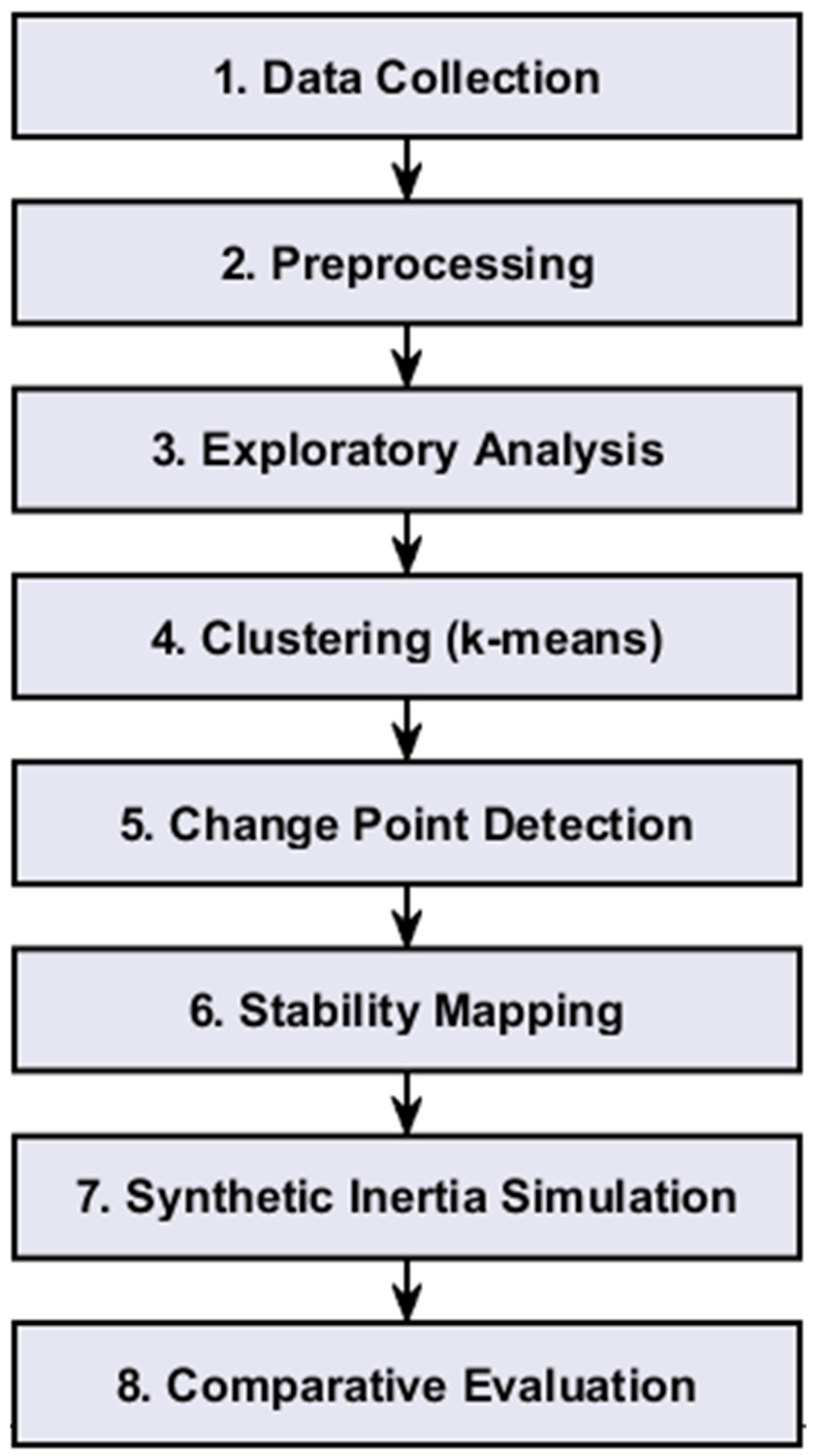
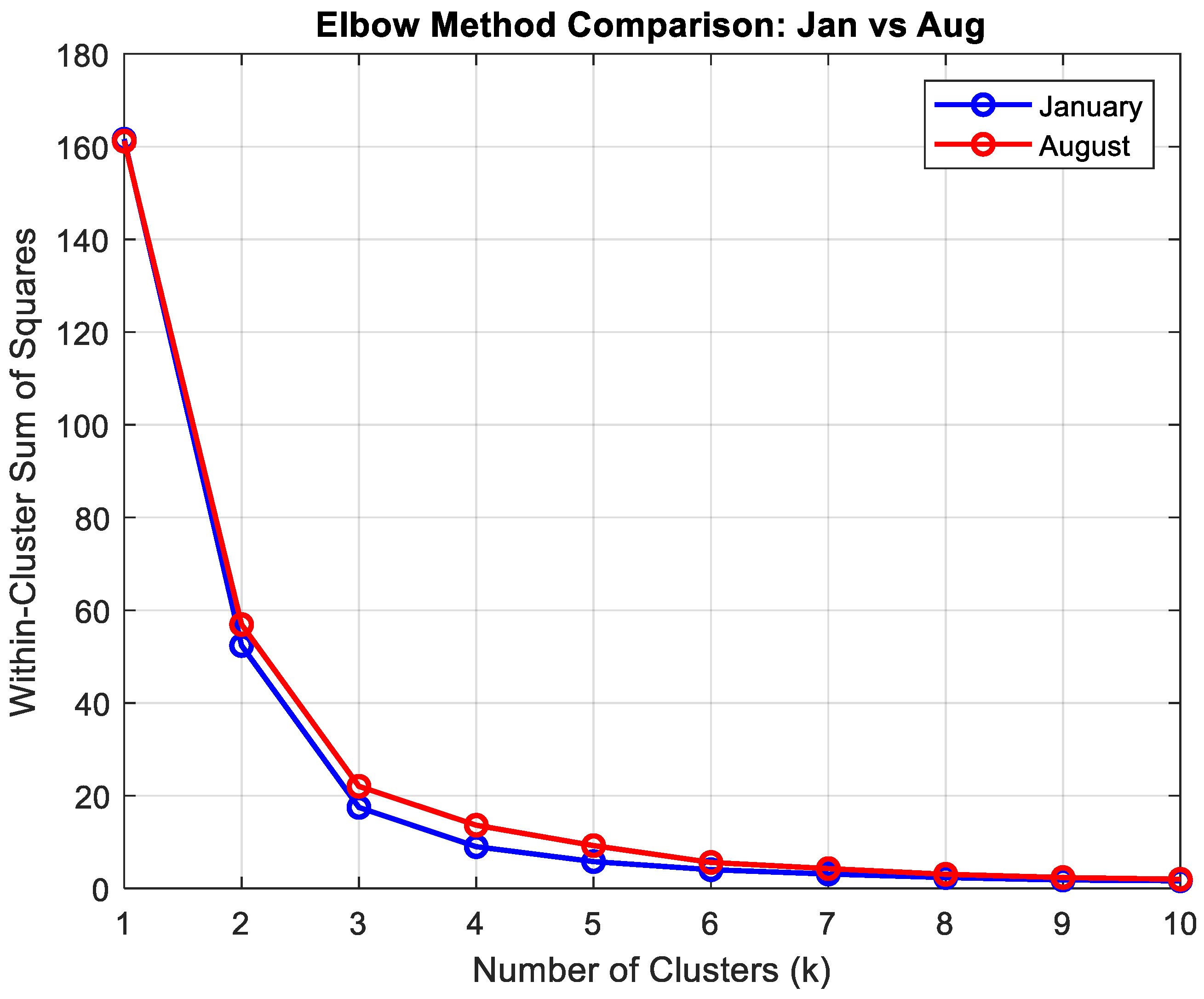

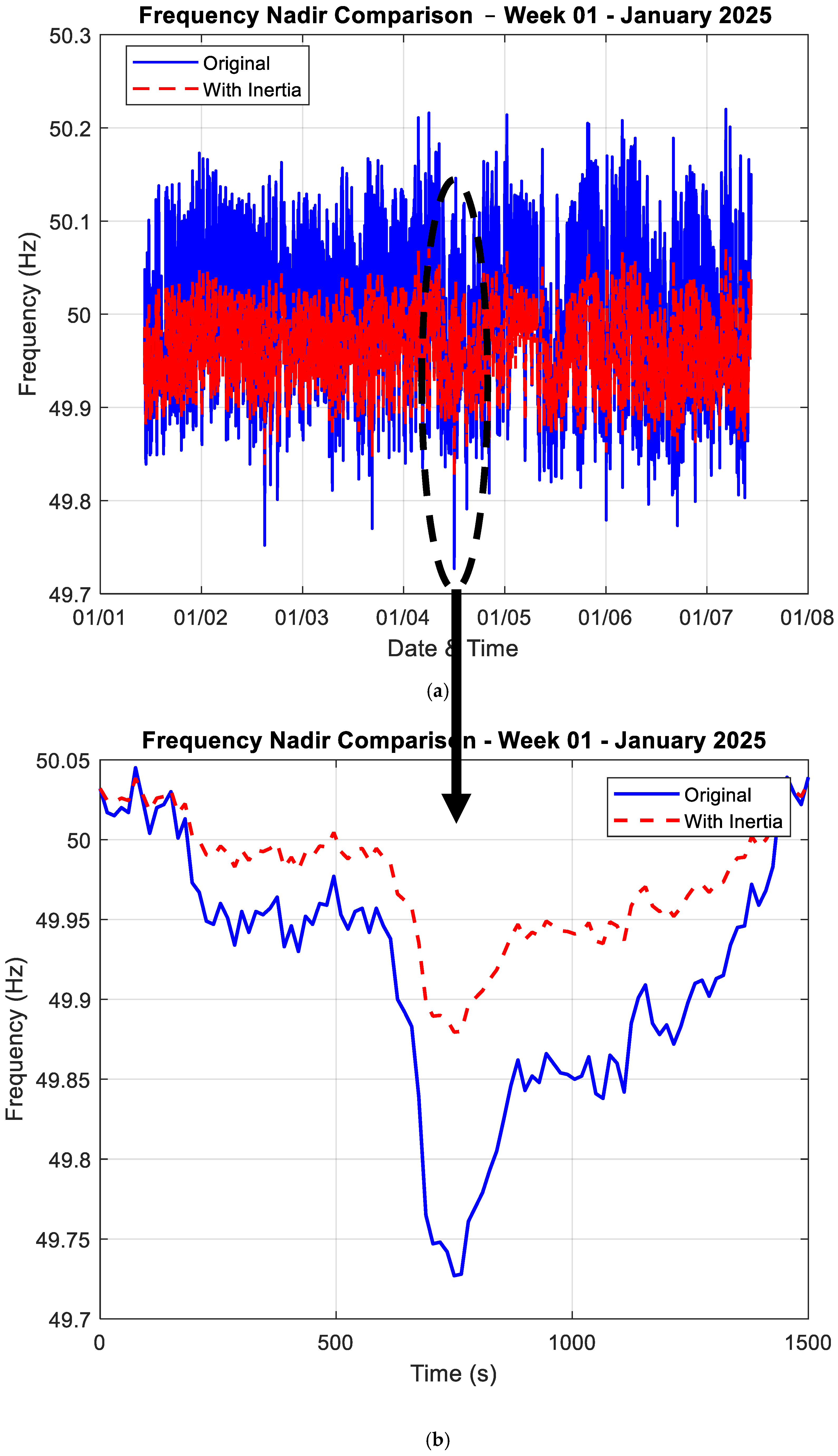
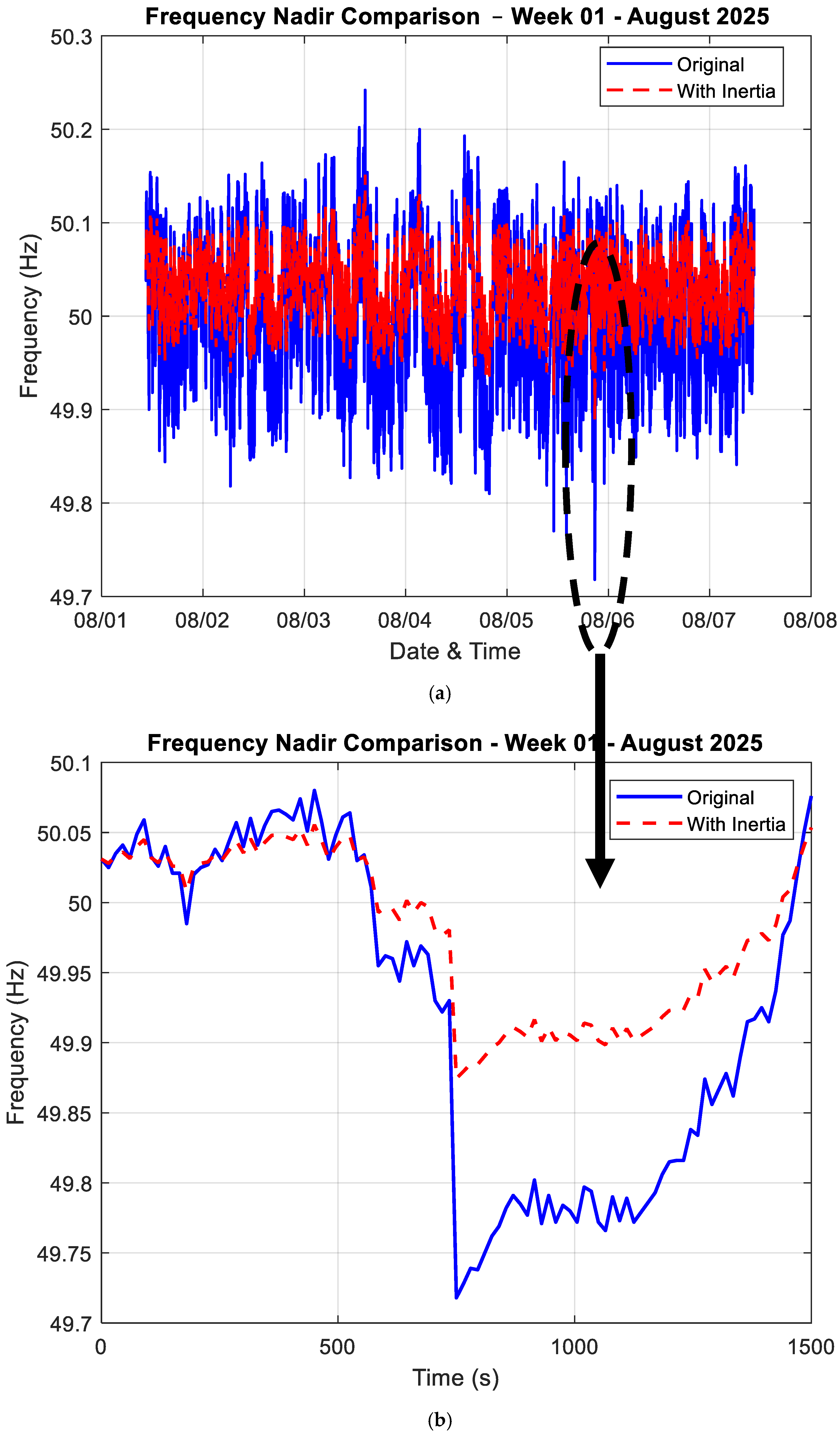
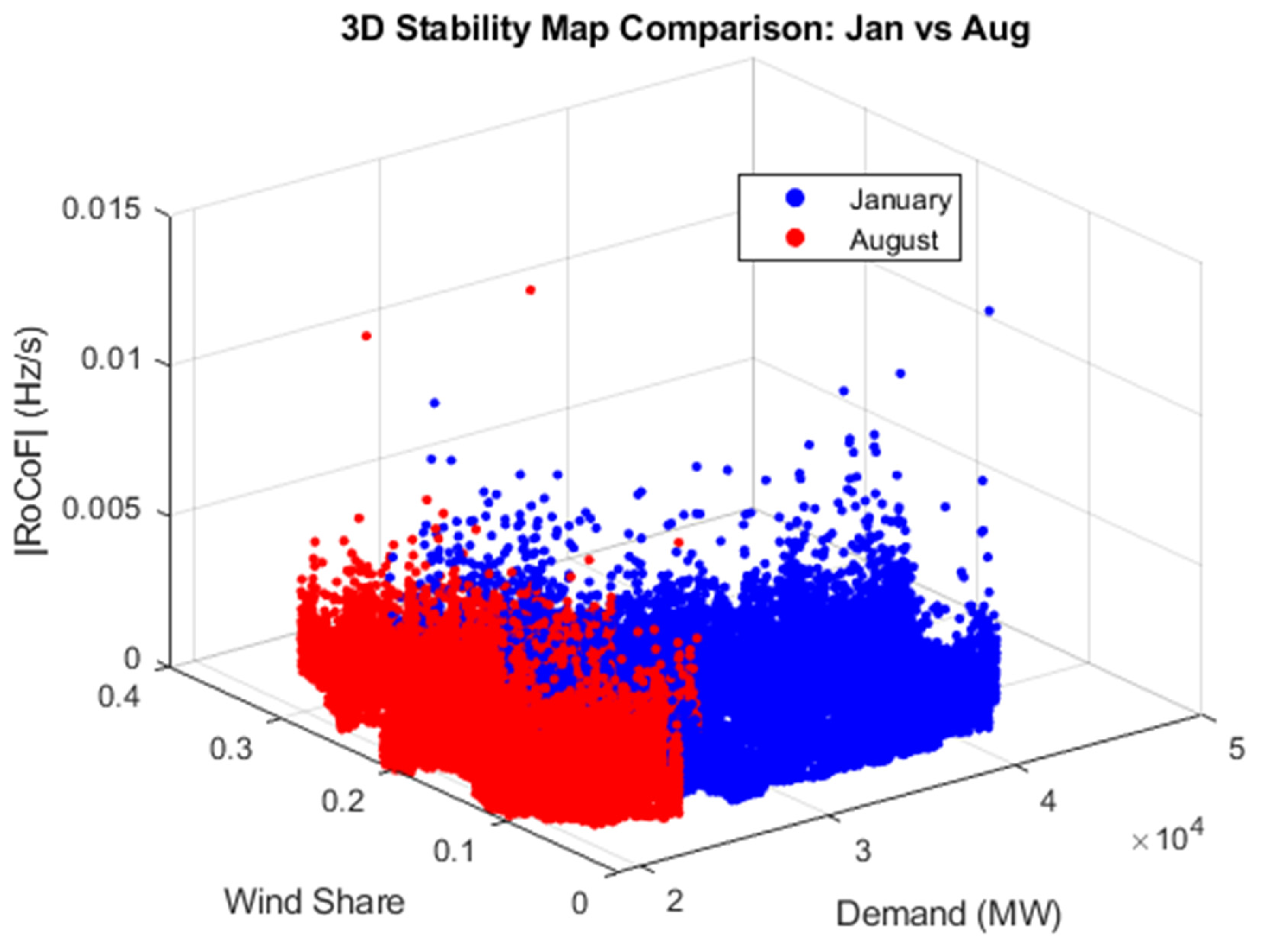
| Dataset | Time Resolution | Columns | Notes |
|---|---|---|---|
| Demand.csv | 5 min | StartTime (ISO8601 UTC), Demand (MW) | 1730 rows |
| Frequency.csv | 15 s | MeasurementTime (ISO8601 UTC), Frequency (Hz) | 34,562 rows |
| Generation.csv | 5 min | StartTime (ISO8601 UTC), FuelType, Generation (MW) | 20 fuel types, data sorted reverse chronological (34,581 rows) |
| Prices.csv | 30 min | StartTime (ISO8601 UTC), SystemSellPrice, SystemBuyPrice (GBP/MWh) | 290 rows |
| Metric | Value | Units | |
|---|---|---|---|
| January | August | ||
| Max RoCoF Observed | 0.012867 | 0.014133 | Hz/s |
| WindShare–RoCoF Correlation | −0.0109 | −0.00303 | — |
| Real Nadir | 49.721 | 49.718 | Hz |
| With inertia | 49.89 | 49.87 | |
| Improvement | 0.152 | 0.156 | |
| Cost per Hz avoided | 3054.8 | 2960.3 | £ |
Disclaimer/Publisher’s Note: The statements, opinions and data contained in all publications are solely those of the individual author(s) and contributor(s) and not of MDPI and/or the editor(s). MDPI and/or the editor(s) disclaim responsibility for any injury to people or property resulting from any ideas, methods, instructions or products referred to in the content. |
© 2025 by the author. Licensee MDPI, Basel, Switzerland. This article is an open access article distributed under the terms and conditions of the Creative Commons Attribution (CC BY) license (https://creativecommons.org/licenses/by/4.0/).
Share and Cite
Amamra, S.-A. Quantifying the Need for Synthetic Inertia in the UK Grid: Empirical Evidence from Frequency Demand and Generation Data. Energies 2025, 18, 5345. https://doi.org/10.3390/en18205345
Amamra S-A. Quantifying the Need for Synthetic Inertia in the UK Grid: Empirical Evidence from Frequency Demand and Generation Data. Energies. 2025; 18(20):5345. https://doi.org/10.3390/en18205345
Chicago/Turabian StyleAmamra, Sid-Ali. 2025. "Quantifying the Need for Synthetic Inertia in the UK Grid: Empirical Evidence from Frequency Demand and Generation Data" Energies 18, no. 20: 5345. https://doi.org/10.3390/en18205345
APA StyleAmamra, S.-A. (2025). Quantifying the Need for Synthetic Inertia in the UK Grid: Empirical Evidence from Frequency Demand and Generation Data. Energies, 18(20), 5345. https://doi.org/10.3390/en18205345







